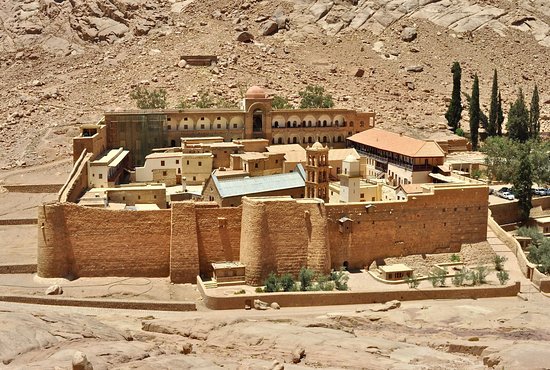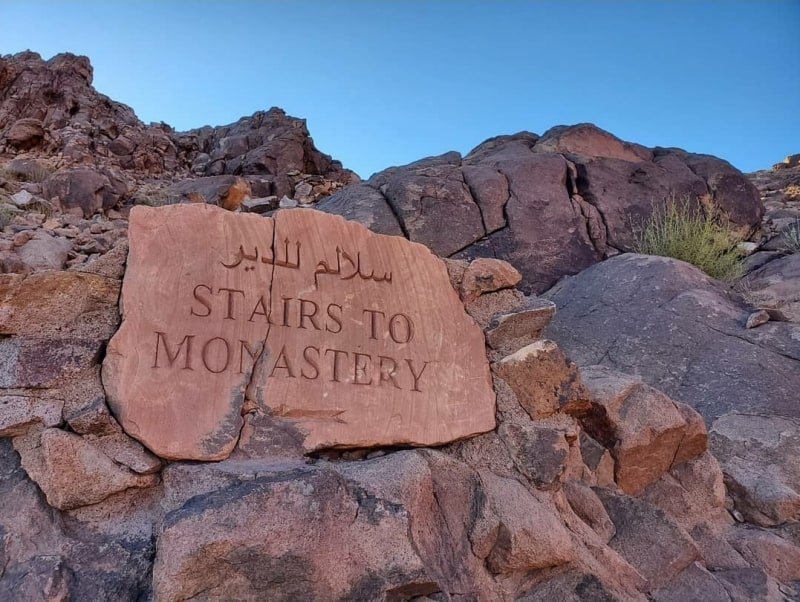
(+2) 01117005089
booking@cairoprivatetours.com

Mount Sinai is revered by Jews, Christians, and Muslims alike as the place where Moses received the Ten Commandments. And, according to belief, it was in the valley below that God spoke to him from a burning bush.
Nestled in the shadow of the sacred mountain is the Monastery of St. Catherine (Deir Sant Katreen), where communities of monks have lived almost uninterruptedly since its founding in the sixth century. Before the monastery, there was a chapel on this site, established in the fourth century AD. by Empress Helena at the place where tradition says that Moses saw the burning bush. This soon became a Place of pilgrimage, and in the sixth: century a fortified monastery was added by Emperor Justinian to protect the monks and pilgrims from raiders. It was not until much; later that the establishment was dedicated to St. Catherine.
She was an early Christian saint who was martyred in Alexandria in the fourth century. After being tortured on a spiked wheel (hence the catherine wheel firework), she was beheaded. According to legend, her body was carried away by angels, to be found, uncorrupted, six centuries later by monks on Mount St. Catherine (Gebel Katarina), a neighbor of Mount Sinai and at 8,665 feet (2,642 m) the highest mountain in Egypt.
Once entailing difficult and 3 dangerous journeys for would-be visitors, the monastery is now served by a good road connecting it to the Red Sea resorts. Many people visit on a half-day trip arranged by Cairo Private Tours and, as a consequence, the small village of St. Catherine close by the monastery is often busy with tour buses and people, especially in the mornings. One way to avoid the crowds is to make your own way to St. Catherine’s by regular public transportation and find accommodations in the village; there is plenty of choices.
Entry to the monastery is through a small postern in the imposing curtain wall, which in places is up to almost 9 feet (3 m) thick. Because of its working nature, most of the monastery is off-limits to the public. The only building open is the Basilica of the Transfiguration (also known as the Church of St. Catherine), added by Justinian in the sixth century. Even though much of this is roped off, it is worth visiting for the splendid display of priceless icons in the antechamber. These are just a small sample of some 2,000 icons held by the monastery, including some of the oldest in existence, dating back to the fifth century. St. Catherine’s library also has the most important collection of religious manuscripts after the Vatican. The monks’ reluctance to allow access to these valuable documents is understandable; in the 19th century, a German scholar borrowed one of their rarest, the fourth-century Codex Sinaiticus, and never returned it. It is now held by the British Library. However, scholars worldwide will soon have access to at least a part of the monastery’s collection via the Internet, as the computer-savvy monks are adding them to St. Catherine’s website.
Behind the basilica, the Well of Moses marks the place where the patriarch is believed to have met his future wife, Zipporah. Close by is a large bush protected by a wooden lattice; this is a transplant of what was claimed to be the original burning bush. Uniquely for a Christian monastery, St. Catherine’s contains a mosque within its walls, opposite the entrance to the basilica. It was built for a Bedouin who worked for the monks. It has probably also helped avoid attacks by Muslims over the centuries.
Outside the high walls are the monastery gardens, with an orchard of olive and apricot trees shading a cemetery, from which the monks’ bones are periodically exhumed and transferred to the nearby Charnel House. This rather macabre display of skulls and assorted bones is usually open to visitors. The robed skeleton is that of Stephanos, a sixth-century guardian of the Mount Sinai path.
At a height of 7,500 feet (2,285 m), Mount Sinai (in Arabic, Gebel Musa, the Mountain of Moses) towers over St. Catherine’s Monastery. It is identified with the biblical Mount Horeb, where Moses spent 40 days and received the tablets bearing God’s commandments. Some archaeologists and historians dispute this claim and place Mount Horeb variously in Saudi Arabia and Jordan, but that hardly seems to deter the hordes of pilgrims who turn up here each day. Visitors here are not just the religious; coming after a visit to the monastery to watch the sunrise from the top of Mount Sinai is de rigueur for almost all travelers coming to Sinai. Consequently, the predawn hours on the mountain can be a distinctly unsacred mix of tour groups tripping oversleeping backpackers, and church groups singing rival hymns. The views, however, are spectacular and are worth the climb.
There are two ways up the mountain. For the fit, there are the 3,750 Steps of Repentance, supposedly, hewn by a penitent monk; this is the most direct route. There are several votive sites en route, including the Gate of Confession, where a monk once heard pilgrims’ confessions. More meandering but slightly easier on the leg muscles is the camel path, which begins behind the monastery. On average, depending on your fitness, it takes about two to three hours to climb to the summit. Bedouins with camels place themselves strategically along the route to offer their services to anyone with faltering legs.
The camel path joins up with the last 750 Steps of Repentance at Elijah’s Basin. This mountainside hollow is dominated by a 500-year-old cypress tree marking the spot where the Bible recounts that God spoke to Elijah as he hid from Jezebel. If you spend the night, this is where you are asked to sleep,
There are self-composting toilets and stands selling tea and snacks. Even in summer, it gets cold and windy in the early hours of the morning, so warm clothes and a sleeping bag are a must. There is no space to pitch a tent. From here it is a short climb to the summit to watch the sunrise.
On the summit, itself is the Greek Orthodox Chapel of the Holy Trinity, built in 1934 on the ruins of a fourth-century church. It contains beautiful paintings and ornaments, and a small mosque. However, these were so desecrated by tourists in the 1980s that the chapel is usually kept locked. The summit also offers a breathtaking panorama of the whole of southern Sinai right across to the Gulf of Aqaba.